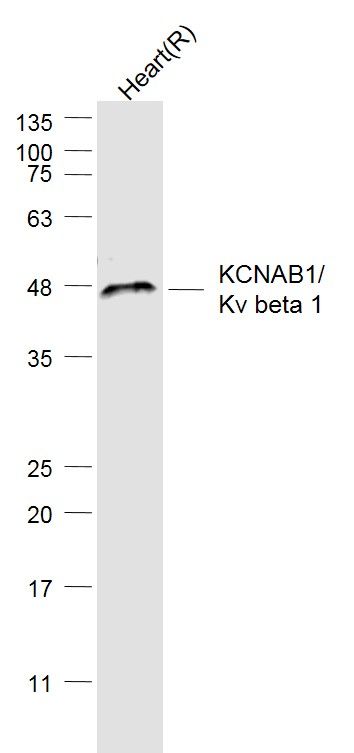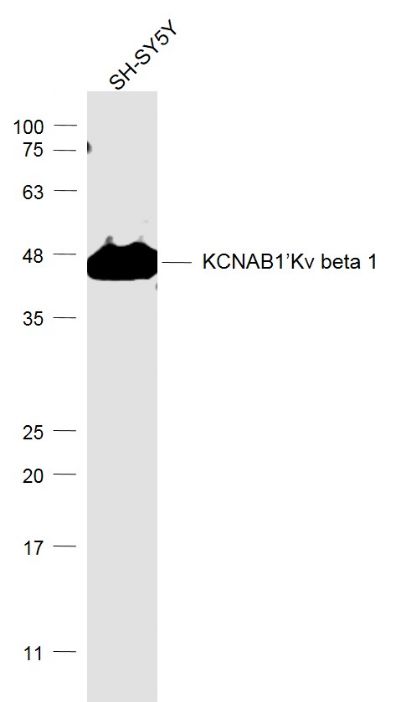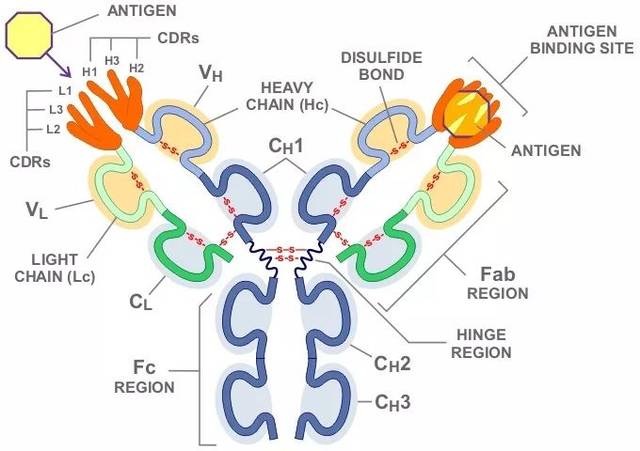Product Name :
KCNAB1/Kv beta 1 Polyclonal Antibody Background :
Voltage-gated K+ channels in the plasma membrane control the repolarization and the frequency of action potentials in neurons, muscles and other excitable cells. The KV gene family encodes more than 30 proteins that comprise the subunits of the K+ channels, and they vary in their gating and permeation properties, subcellular distribution and expression patterns. Functional KV channels assemble as tetramers consisting of pore-forming å subunits (KV), which include the KV1, KV2, KV3 and KV4 proteins, and accessory or KV-subunits that modify the gating properties of the coexpressed KV subunits. KV∫, also known as KCNAB1 (potassium voltage-gated channel, shaker-related subfamily, beta member 1), is a 419 amino acid accessory K+ channel protein that exists as three alternatively spliced isoforms and regulates the activity of the pore-forming å subunit. It is expressed in brain, with highest levels detected in caudate nucleus, hippocampus and thalamus. Product :
0.01M TBS(pH7.4) with 1% BSA, 0.03% Proclin300 and 50% Glycerol. Storage&Stability :
Store at 4°C short term. Aliquot and store at -20°C long term. Avoid freeze-thaw cycles. Specificity :
KCNAB1/Kv beta 1 Polyclonal Antibody detects endogenous levels of KCNAB1/Kv beta 1 protein. Immunogen :
KLH conjugated synthetic peptide derived from human KCNAB1/Kv beta 1:131-230/419 Conjugate :
Unconjugated Modification :
Unmodification
KCNAB1/Kv beta 1 Polyclonal Antibody Background :
Voltage-gated K+ channels in the plasma membrane control the repolarization and the frequency of action potentials in neurons, muscles and other excitable cells. The KV gene family encodes more than 30 proteins that comprise the subunits of the K+ channels, and they vary in their gating and permeation properties, subcellular distribution and expression patterns. Functional KV channels assemble as tetramers consisting of pore-forming å subunits (KV), which include the KV1, KV2, KV3 and KV4 proteins, and accessory or KV-subunits that modify the gating properties of the coexpressed KV subunits. KV∫, also known as KCNAB1 (potassium voltage-gated channel, shaker-related subfamily, beta member 1), is a 419 amino acid accessory K+ channel protein that exists as three alternatively spliced isoforms and regulates the activity of the pore-forming å subunit. It is expressed in brain, with highest levels detected in caudate nucleus, hippocampus and thalamus. Product :
0.01M TBS(pH7.4) with 1% BSA, 0.03% Proclin300 and 50% Glycerol. Storage&Stability :
Store at 4°C short term. Aliquot and store at -20°C long term. Avoid freeze-thaw cycles. Specificity :
KCNAB1/Kv beta 1 Polyclonal Antibody detects endogenous levels of KCNAB1/Kv beta 1 protein. Immunogen :
KLH conjugated synthetic peptide derived from human KCNAB1/Kv beta 1:131-230/419 Conjugate :
Unconjugated Modification :
Unmodification
-
 Primary: Anti-KCNAB1’Kv beta 1 at 1/500 dilution
Primary: Anti-KCNAB1’Kv beta 1 at 1/500 dilution -
 Primary: Anti-KCNAB1’Kv beta 1 at 1/1000 dilution
Primary: Anti-KCNAB1’Kv beta 1 at 1/1000 dilution
Bioworld Biotech only provide peptides for our antibodies and do not provide additional peptide customization services.
Price/Size :
USD 368/1mg/vial
Tips:
For phospho antibody, we provide phospho peptide(0.5mg) and non-phospho peptide(0.5mg).Describe :
Blocking peptides are peptides that bind specifically to the target antibody and block antibody binding. These peptide usually contains the epitope recognized by the antibody. Antibodies bound to the blocking peptide no longer bind to the epitope on the target protein. This mechanism is useful when non-specific binding is an issue, for example, in Western blotting (WB) and Immunohistochemistry (IHC). By comparing the staining from the blocked antibody versus the antibody alone, one can see which staining is specific; Specific binding will be absent from the western blot or IHC performed with the neutralized antibody.Formula:
Synthetic peptide was lyophilized with 100% acetonitrile and is supplied as a powder. Reconstitute with 0.1 ml DI water for a final concentration of 10 mg/ml.The purity is >90%,tested by HPLC and MS.
Storage:
The freeze-dried powder is more stable. For short time at 2-8°C. For long term storage store at -20°C.
Note :
This product is for research use only (RUO only). Not for use in diagnostic or therapeutic procedures.
 KCNAB1/Kv beta 1 Polyclonal Antibody
KCNAB1/Kv beta 1 Polyclonal Antibody  Datasheet
Datasheet COA
COA MSDS
MSDS SHIP
SHIP